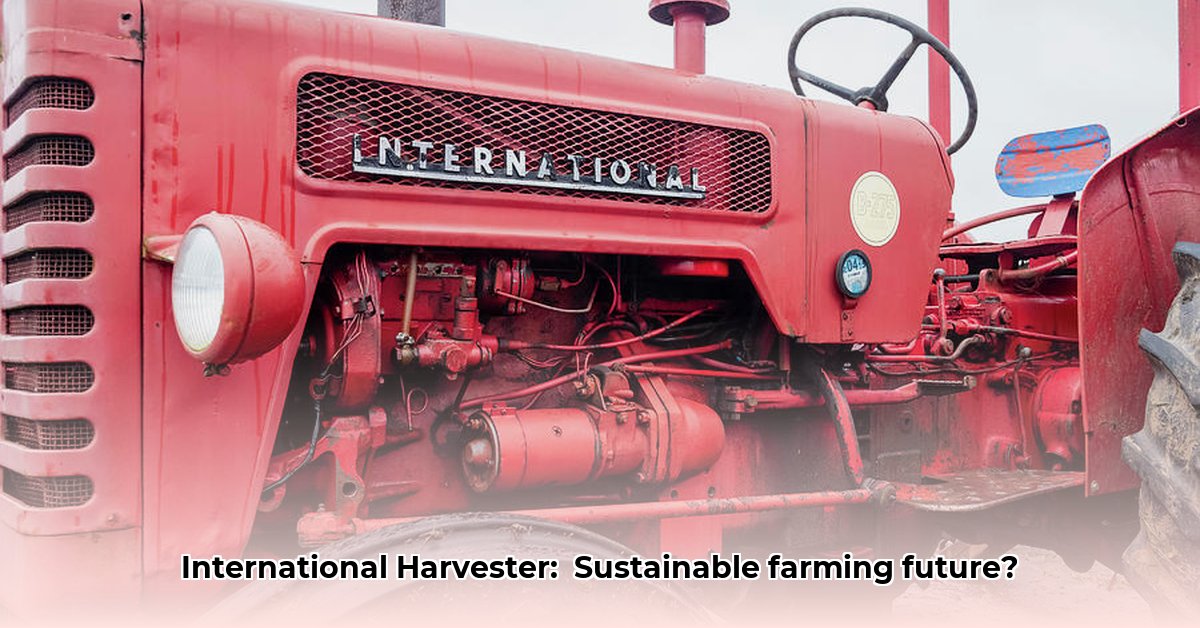
A Legacy Forged in Steel and Fuel: The Rise of International Harvester
The iconic rumble of an International Harvester (IH) tractor evokes a bygone era of American agriculture. But beyond the nostalgic sound, lies a complex legacy intertwined with the evolution of farming practices and the burgeoning concept of sustainable agriculture. Did these workhorses pave the way for environmentally friendly farming, or did their very existence leave an indelible, less-than-sustainable mark on the land? This is a question worthy of careful examination. For more details on IH history, check out this IH Tractor History.
The story begins in 1923 with the revolutionary Farmall tractor. While sustainability wasn't a primary design consideration at the time, the Farmall's impact on efficiency was undeniable. Farmers could cultivate significantly more land, potentially resulting in less land needed for the same output—a seemingly positive contribution to environmental sustainability. This increased efficiency, however, is a double-edged sword. It facilitated the rise of larger, more mechanized farms, sometimes leading to decreased biodiversity and a shift away from more environmentally sensitive farming practices. Did increased output justify the trade-offs? That remains a key question.
Beyond the Farmall: Technological Advancements and Their Environmental Footprint
International Harvester's innovations didn't end with the Farmall. The Axial-Flow combine, introduced in 1977, significantly reduced post-harvest crop losses, resulting in improved resource utilization. Less waste equates to a more environmentally responsible operation, right? Yes, but only partially. The picture is far more complex than that. We must also consider the increasing reliance on fossil fuels, the environmental impact of manufacturing these machines, and what happens to them upon the end of their lifespan.
Later innovations, such as computer-integrated systems like Sentry, aimed to optimize fuel consumption and other aspects of farming. While these advancements point towards a more sustainable future, their overall environmental impact necessitates more extensive research. How efficiently did they reduce fuel use in practice? Did this outweigh the environmental cost of their manufacturing and disposal processes? These are crucial questions researchers continue to explore.
The Environmental Accounting: A Complex Equation
Were IH tractors truly "green"? The straightforward answer is: we don't know definitively. Comprehensive data regarding their entire life cycle—from manufacture to disposal—is often lacking. Accurate estimations of fuel consumption, emissions, material sourcing and their environmental impact are all critical for establishing a complete picture. This data deficit highlights a crucial lesson: simply increasing yields doesn't automatically equate to sustainable agricultural practices.
Professor Anya Sharma, Environmental Engineering, University of California, Berkeley, states: "To accurately evaluate the historical environmental impact of agricultural machinery, we need thorough, long-term datasets that account for all stages of the product's life cycle. This is often extraordinarily challenging with older technology."
CNH Industrial: A Legacy Continued, A Responsibility Renewed
International Harvester may be a part of history, but its legacy lives on through CNH Industrial. This inheritance carries with it a responsibility to address the environmental challenges posed by past manufacturing practices and to actively shape a sustainable agricultural future. CNH Industrial, and the wider agricultural machinery industry, must prioritize life-cycle assessments (LCAs) of their products, set ambitious targets for emission reductions, and invest heavily in research and development of truly sustainable technologies.
Charting a Greener Course: A Multi-Stakeholder Approach
Understanding the true legacy of IH tractors and building a sustainable agricultural future requires collaborative action. This includes:
- Manufacturers: Conducting comprehensive LCAs, setting ambitious sustainability targets, and investing in green technology R&D.
- Farmers: Adopting precision agriculture, using fuel-efficient equipment, and employing methods like no-till farming.
- Researchers: Continuing detailed investigations into the historical environmental impact of agricultural machinery.
- Policymakers: Implementing policies and regulations that support sustainable machinery development and practices.
The Verdict: A Nuanced Perspective
The story of International Harvester tractors is a complex one. While these machines undoubtedly revolutionized farming, increased efficiency, and arguably contributed to some aspects of sustainability through reduced land use per output, their long-term environmental effect remains a subject of ongoing investigation. The future demands a collaborative commitment to data-driven decision-making and a proactive approach to sustainable practices. Only then can we truly assess the full legacy of IH and work towards a genuinely greener future for agriculture.
Key Takeaways:
- IH tractors significantly impacted farming efficiency, indirectly contributing to some aspects of sustainability.
- Their heavy reliance on fossil fuels remains a major environmental concern.
- A comprehensive assessment requires a multifaceted approach, considering every element of a machine's life cycle.
- Modern manufacturers must learn from IH's durability while adopting sustainable technologies.
- Farmers play a vital role in adopting sustainable practices and technologies.